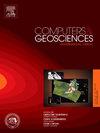Thin layer identification method of prestack seismic data based on an improved 2D Teager-Huang transform
IF 4.2
2区 地球科学
Q1 COMPUTER SCIENCE, INTERDISCIPLINARY APPLICATIONS
引用次数: 0
Abstract
Thin layer identification is significant in reservoir prediction, especially in deep and ultradeep reservoirs. Due to the weak effective signals of deep reservoirs, the effectiveness of the current thin layer positioning method is significantly reduced. Therefore, an improved 2D Teager-Huang transform (2D-THT) operator based on prestack seismic data is developed in this paper to identify and locate deep thin reservoirs. First, we combine bidimensional empirical mode decomposition (BEMD) and ensemble empirical mode decomposition (EEMD) to form the bidimensional ensemble empirical mode decomposition (BEEMD) algorithm. This BEEMD algorithm can effectively avoid the mode mixing problem of BEMD and efficiently decompose gathers to separate and extract the critical information. Then, we introduce a 2D Teager-Kaiser energy operator (2D-TKEO) to enhance the lateral and longitudinal instantaneous change characteristics of the selected effective components and focus on the weak reflection signal. Finally, the Hilbert transform is used to obtain the prestack spectral decomposition results, and the time–frequency superposition spectrum is obtained through superposition. The positions of the thin layer top and bottom are obtained by locating the frequency change point. This method uses the intrinsic signal change to obtain a strong sensitivity to thin layers to achieve thin reservoir positioning research. Synthetic data and actual data application examples of deep carbonate rocks in western Sichuan show that a method complementary to the existing thin layer detection methods is proposed in this paper and that good results on low signal-to-noise ratio data are achieved.
基于改进二维Teager-Huang变换的叠前地震资料薄层识别方法
薄层识别在储层预测,特别是深层和超深层储层预测中具有重要意义。由于深层储层有效信号较弱,现有薄层定位方法的有效性显著降低。为此,本文提出了一种改进的基于叠前地震数据的二维Teager-Huang变换(2D- tht)算子,用于深层薄储层的识别与定位。首先,将二维经验模态分解(BEMD)与系综经验模态分解(EEMD)相结合,形成二维系综经验模态分解(BEEMD)算法。该BEEMD算法可以有效地避免BEEMD的模式混合问题,并有效地分解聚类,分离和提取关键信息。然后,我们引入二维Teager-Kaiser能量算子(2D- tkeo)来增强所选有效分量的横向和纵向瞬时变化特征,并重点关注弱反射信号。最后利用希尔伯特变换得到叠前频谱分解结果,通过叠加得到时频叠加频谱。通过定位频率变化点,得到薄层顶部和底部的位置。该方法利用本征信号变化对薄层具有较强的敏感性,实现薄层储层定位研究。综合数据和川西深层碳酸盐岩的实际数据应用实例表明,本文提出了一种与现有薄层探测方法相补充的方法,在低信噪比数据上取得了较好的效果。
本文章由计算机程序翻译,如有差异,请以英文原文为准。
求助全文
约1分钟内获得全文
求助全文
来源期刊

Computers & Geosciences
地学-地球科学综合
CiteScore
9.30
自引率
6.80%
发文量
164
审稿时长
3.4 months
期刊介绍:
Computers & Geosciences publishes high impact, original research at the interface between Computer Sciences and Geosciences. Publications should apply modern computer science paradigms, whether computational or informatics-based, to address problems in the geosciences.
 求助内容:
求助内容: 应助结果提醒方式:
应助结果提醒方式:


